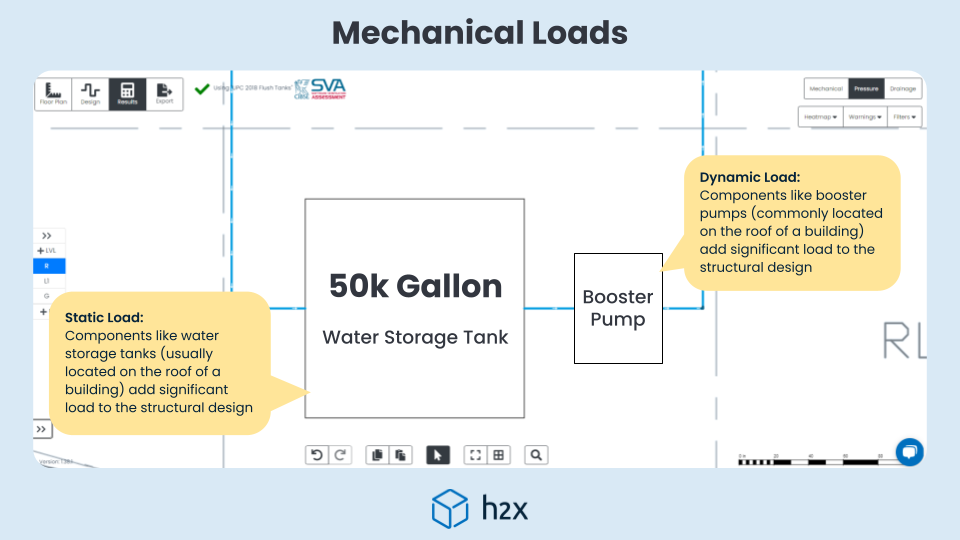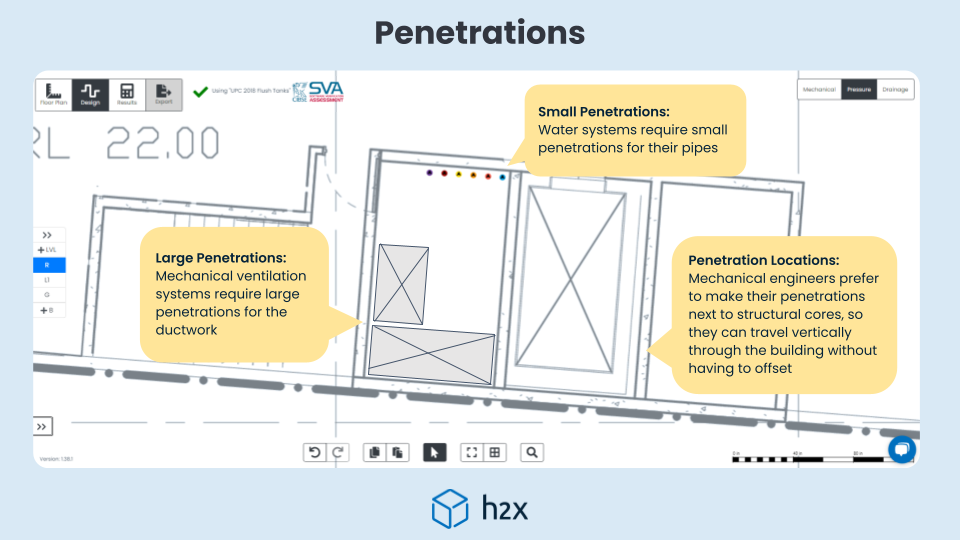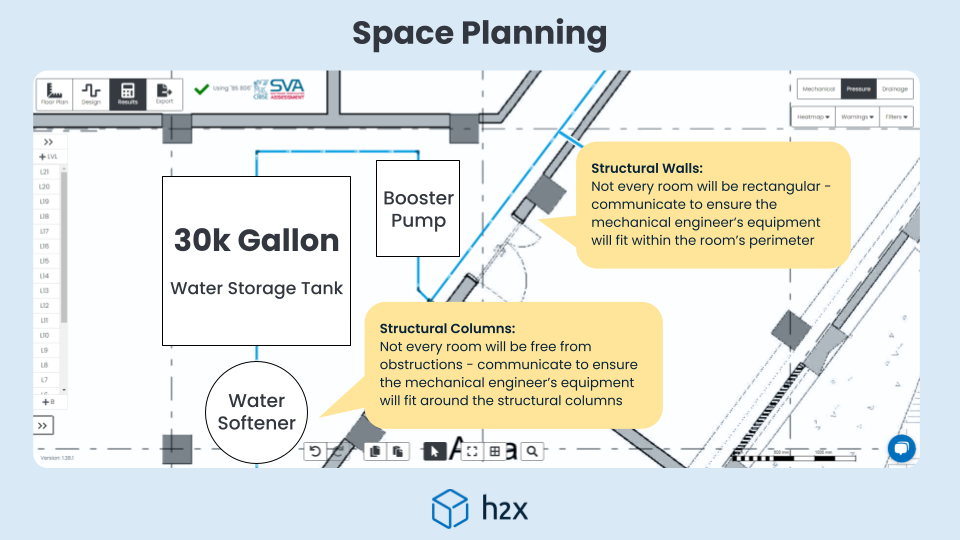Σε οποιοδήποτε οικοδομικό έργο, δύο κλάδοι ξεχωρίζουν για τον αντίκτυπό τους στη μορφή και τη λειτουργικότητα ενός κτιρίου: δομικής και μηχανολογίας. While structural engineering ensures the building stands strong and stable, mechanical engineering integrates systems that provide essential services like heating, cooling, and plumbing. Though distinct, these fields often overlap, making their coordination vital. Missteps or miscommunication can lead to costly delays, design revisions, or even safety concerns.
Αυτό το ιστολόγιο εμβαθύνει στις βασικές διασταυρώσεις αυτών των κλάδων, highlighting the challenges and solutions in harmonizing their requirements. Σε συνεργασία με h2x Μηχανική, διερευνούμε πέντε βασικά βήματα που θα οδηγήσουν σε κτίρια που είναι ταυτόχρονα στιβαρά και αποτελεσματικά.
Επικοινωνία: Ο ουσιαστικός σύνδεσμος στο σχεδιασμό κτιρίων
Στον πυρήνα του, communication in construction transcends mere dialogue. Είναι η περίπλοκη ανταλλαγή τεχνικών δεδομένων, σχεδιαστική πρόθεση, περιορισμούς, and feedback. Given the nature of modern construction projects, where various specialities converge, communicating accurate information is critical. Structural and mechanical engineers, though operating in different spheres, deeply influence each other’s work. Proper communication ensures that design decisions are informed, practical, and synergistic.
Hypothetical Example:
Consider a futuristic museum, designed with sweeping curves and vast open spaces, planning to house an environmentally controlled exhibit for delicate artefacts. The structural team envisions a particular type of reinforced concrete to achieve the desired aesthetics. Simultaneously, the mechanical team identified a need for extensive ductwork to control the exhibit’s climate. Without clear communication, the structural team might finalize designs that don’t accommodate this ductwork. This oversight could lead to costly redesigns, compromises in aesthetic intent, or even inefficiencies in the climate control system.
Information the Structural Engineer Requires:
- Preliminary and final designs of mechanical systems, highlighting their spatial and load requirements.
- Constraints or challenges the mechanical team foresees, such as specific vibration control needs or temperature-related expansions.
- Regular updates as the mechanical design evolves, ensuring that late-stage changes don’t clash with established structural plans.
Information the Mechanical Engineer Requires:
- Detailed structural layouts that indicate primary load-bearing elements, zones of flexibility, and areas with limited access or modification potential.
- Insights into potential structural changes, adaptations, or innovations that might affect mechanical design or routing.
- Feedback loops for iterative collaboration, allowing the mechanical team to adjust designs in response to structural feedback.
Mechanical Loads: Deciphering Static and Dynamic Forces
At the heart of structural design lies the task of accommodating loads. While dead loads (from the structure itself) και ζωντανά φορτία (from occupants and furnishings) are fundamental considerations, mechanical loads add another layer of complexity.
 These can be classified into:
These can be classified into:
- Στατικά φορτία: This is the unchanging weight or force exerted by stationary mechanical equipment, such as the weight of an air handling unit.
- Δυναμικά Φορτία: These are varying forces or additional stresses introduced by the operation of mechanical systems. They often arise due to moving parts within the system, fluctuations in operational intensity, or even the start-up and shutdown sequences.
Mechanical systems, by their nature, possess weight (static loads) and have operational characteristics that generate forces (δυναμικά φορτία). A pumping station, για παράδειγμα, while having a fixed weight, will also create forces when pumps activate, pushing water throughout a building.
Hypothetical Example:
Consider a high-rise residential tower incorporating a large air handling unit. The equipment, housed at the top of the building, imparts a constant static load on the building. Ωστόσο, as the system operates, it introduces dynamic forces, varying based on the speed of operation. If these dynamic forces align with the building’s natural frequency, they could cause resonant vibrations, potentially leading to accelerated structural fatigue or even perceptible sway.
Information the Structural Engineer Requires:
- Comprehensive data sheets of all mechanical equipment, detailing weight, operational characteristics, and any cyclic or transient forces expected during operation.
- Point of application of these loads, which could affect how forces are distributed across structural elements.
- Information on potential variations in these loads, such as seasonal changes in HVAC operations or varying elevator usage patterns during the day.
Information the Mechanical Engineer Requires:
- Data on the structural elements’ load-bearing capacities, ensuring equipment placement adheres to these limits.
- Feedback on structural resonant frequencies or any other constraints that could influence the mechanical system’s operation or placement.
- Information on any planned structural modifications or updates that could affect the mechanical system’s performance or integration.
Penetrations: The Choreography of Structure and Mechanical Systems
Penetrations represent the intentional openings or pathways created within structural elements to accommodate mechanical systems. They can be anything from small holes for electrical conduits to larger openings for HVAC ducts or plumbing. As buildings aim to be more integrated and compact, the need arises for mechanical systems to traverse through structural components. Whether it’s to ensure an optimized layout, maintain aesthetics, or simply provide essential utilities across the building, these penetrations become a crucial part of the design process.

Hypothetical Example:
Imagine an upscale office building with a focus on open spaces and minimalist design. To maintain this aesthetic, HVAC ducts are planned to run through the building’s primary beams, requiring substantial penetrations. If these penetrations are not adequately accounted for during design, they could compromise the beams’ load-bearing capacity. Στο περασμα του χρονου, these compromised beams might exhibit signs of stress, like cracking or excessive deflection, potentially endangering the building’s integrity.
Information the Structural Engineer Requires:
- Detailed mechanical layouts indicating required penetrations, their sizes, and locations.
- Any potential variations or adjustments to these penetrations, such as alternative routing options or flexibility in their sizing.
- Mechanical requirements, such as insulation or protective linings, that might affect the size or nature of the penetration.
Information the Mechanical Engineer Requires:
- Structural blueprints and details, highlighting critical load-bearing elements and zones of high structural importance.
- Constraints or guidelines related to penetrations, like maximum allowable sizes or locations to avoid.
- Feedback on potential structural reinforcements or modifications, which might offer more flexibility in mechanical routing.
Vibrations: Oscillations from Mechanical Systems
Vibrations represent the rhythmic oscillations or movements within building elements, often triggered or intensified by mechanical systems. While some vibrations are benign, others can be potent enough to cause discomfort, compromise structural integrity, or even impact the longevity of both structural and mechanical components. In the built environment, vibrations are a natural phenomenon, stemming from various sources like wind, σεισμική δραστηριότητα, or human occupancy. Ωστόσο, mechanical systems, due to their inherent design and functionality, often introduce additional vibrations.
Hypothetical Example:
Imagine a concert hall, renowned for its pristine acoustics. To maintain an ideal temperature and humidity level, a powerful HVAC system operates in the background. Ωστόσο, when this system starts up, it introduces vibrations that travel through the building’s structure. These vibrations, though subtle, interfere with the hall’s acoustics during quiet musical passages. Without prior coordination between structural and mechanical engineers, the hall might face challenges in delivering the sound quality it’s renowned for.
Information the Structural Engineer Requires:
- Detailed specifications of all mechanical equipment, especially those with high dynamic loads or rotating components.
- Operational schedules and frequency patterns offer insights into when and how often these vibrations might occur.
- Any mechanical design provisions already in place to dampen or control vibrations, like isolators or specific mounting techniques.
Information the Mechanical Engineer Requires:
- The building’s natural frequencies and any known zones are particularly sensitive to vibrations.
- Structural measures or materials that inherently dampen vibrations or disperse dynamic loads.
- Feedback on potential structural interventions, such as tuned mass dampers or added bracing, might influence the mechanical design or placement.
Space Planning: Sculpting Harmony between Function and Form
Space planning delves into the allocation, οργάνωση, ένα
d efficient utilization of the physical space within a building. It involves orchestrating how structural components coexist with mechanical systems, all while ensuring optimal functionality and preserving the architectural vision. Buildings are more than just shelter; they’re orchestrated environments tailored for specific uses, aesthetics, and experiences. Ως τέτοια, every inch of space matters. The structural framework provides the necessary support, while mechanical systems offer essential amenities like ventilation, plumbing, and power. The need to house both without compromise necessitates meticulous space planning.
Hypothetical Example:
Visualize a luxury spa resort designed with open ceilings to emphasize tranquillity and openness. But as designs progress, it’s found that the HVAC system requires large ducts, οι οποίες, if not carefully integrated, could hang conspicuously, disrupting the desired ambience. If structural and mechanical engineers hadn’t coordinated early on, the result could be either a compromised design or a costly redesign of the HVAC system.
Information the Structural Engineer Requires:
- Detailed layouts and dimensions of the mechanical systems, allowing an understanding of their spatial requirements.
- Potential flexibility or adaptability in mechanical routing, which could offer solutions in tight spaces or zones of architectural importance.
- Future scalability or modifications in mechanical systems, ensuring the structure can accommodate potential upgrades.
Information the Mechanical Engineer Requires:
- Structural blueprints with marked areas of high importance, περιορισμούς, or limited access, guiding mechanical design decisions.
- Information on any structural features or materials that could influence mechanical system performance, like thermally insulated zones or areas with heightened soundproofing.
- Feedback on potential structural modifications that might offer more space or better integration opportunities.
συμπέρασμα
In the intricate world of construction, the coordination of structural and mechanical systems is key to success. As we’ve explored, this interplay shapes the very essence of our built environment, ensuring not only the strength of our structures but also the functionality that brings them to life. Both disciplines, though distinct in their core principles, intersect in ways that demand clear communication, foresight, and collaborative expertise.



